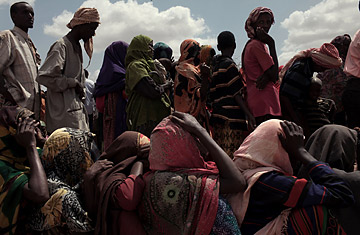
Somali refugees arrive at the Dadaab Refugee Camp in eastern Kenya, July 18, 2011.
The outskirts of the Dadaab refugee complex are jammed with dome-like huts made of sticks, refuse, plastic sheeting and discarded cartons from aid packets. Toilets are scarce, and water is delivered periodically by truck. More than 60,000 people are occupying these makeshift encampments built atop a harsh arid landscape in the far east of Kenya, just over the Somali border. The ragged domes in the desert look like something from the post-apocalyptic world of Mad Max.
The Dadaab refugee complex is already the largest in the world, with more than 380,000 residents - four times the capacity it was built for, when the three encampments that form the complex were built in the early 1990s. The camps no longer accept new admissions, so tens of thousands of new refugees, most of them women and children, that are fleeing Somalia in the wake of the drought that has gripped the horn of Africa are left to set up makeshift housing in the no-mans land that surrounds the official camps. Simply put, there is no place for them in Dadaab itself.
The famine-like conditions in Somalia have led to an increase in the number of refugees coming over the Kenyan border from around 5,000 per month in 2010 to an estimated 30,000 in June. The refugees must make a perilous journey from their conflict-ridden country and navigate for days through forbidding terrain, usually on foot. Most of those who arrive are badly malnourished, and aid workers say that many children did not survive the trip, while others died as soon as they arrived.
Hawa, 40, came here from the Buale district in Somalia after a 23 day trek on foot with her seven children. She left, as did all of her neighbors, because there was not enough food. When fighting arrived in her locale, her husband disappeared, and she fled with the children. Her one year old son, Abdu Noor, is recovering in a hospital run by Doctors Without Borders from severe malnourishment. Now, the rest of her family has settled in a makeshift hut in the outskirts of the official camps, living rough and scrambling for basics like food and water.
Coming here, she had hoped for a safe haven, says Hawa. "What I found is that there is little difference between Somalia and a refugee camp."
The recent surge of refugees has led to a flurry of new media and diplomatic attention, but in truth the conditions in the camps have been bad for years, with four families forced to settle on a plot built for one. Things really began to get bad in January of this year, but despite warnings from aid groups and relief agencies and government drought monitors, the response from international donors was tepid.
"We raised the alarm quite early, but for me, the response was inadequate", says Dr. Edward Chege, the director of the hospital run by Doctors Without Borders in the Dahagely refugee camp. The number of severely malnourished children - meaning they are close to death — at the hospital has swelled from 20 in January to more than 130 now. They expect the number of patients to increase in the coming six months, says Dr. Chege.
Malnutrition rates for small children in the outskirts is around 30%, and about half of those are severe. That is twice as high as the malnutrition rates in the official camps, but even 15% is already at crisis levels. It is usually children under 2 that get the worst of it. That said, aid officials say they are seeing severely malnourished children up to 10 years old, which is extremely unusual and shows the severity of the crisis.
